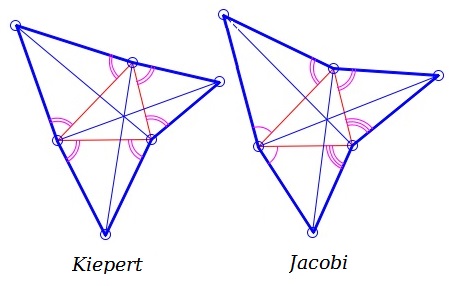Kiepert's And Jacobi's Theorems
What Are They?
A Mathematical Droodle
|Up| |Contact| |Front page| |Contents| |Eye opener| |Geometry|
Copyright © 1996-2018 Alexander Bogomolny
One of the consequences of Napoleon's Theorem is the existence of Fermat's point. The latter is the point of concurrency of the three lines, each joining a vertex of the given triangle with the farthest vertex of the opposite Napoleon triangle.
Ludwig Kiepert showed that concurrency takes place when equilateral triangles are replaced with similar isosceles triangles. Karl Friedrich Andreas Jacobi generalized even further by proving the presence of concurrency in case the add-on triangles share angles pairwise at each of he base triangle vertices.

Kiepert's and Jacobi's Theorems admit a further generalization where the bases of the isosceles triangles need not coincide with the entire sides of the given triangle.
References
- J. Baker, Napoleon's Theorem and Beyond, Spreadsheets in Education, v. 1, n. 2.
- D. Gale, Tracking The Autmatic Ant, Springer-Verlag, 1998
Napoleon's Theorem
- Napoleon's Theorem
- A proof with complex numbers
- A second proof with complex numbers
- A third proof with complex numbers
- Napoleon's Theorem, Two Simple Proofs
- Napoleon's Theorem via Inscribed Angles
- A Generalization
- Douglas' Generalization
- Napoleon's Propeller
- Napoleon's Theorem by Plane Tessellation
- Fermat's point
- Kiepert's theorem
- Lean Napoleon's Triangles
- Napoleon's Theorem by Transformation
- Napoleon's Theorem via Two Rotations
- Napoleon on Hinges
- Napoleon on Hinges in GeoGebra
- Napoleon's Relatives
- Napoleon-Barlotti Theorem
- Some Properties of Napoleon's Configuration
- Fermat Points and Concurrent Euler Lines I
- Fermat Points and Concurrent Euler Lines II
- Escher's Theorem
- Circle Chains on Napoleon Triangles
- Napoleon's Theorem by Vectors and Trigonometry
- An Extra Triple of Equilateral Triangles for Napoleon
- Joined Common Chords of Napoleon's Circumcircles
- Napoleon's Hexagon
- Fermat's Hexagon
- Lighthouse at Fermat Points
- Midpoint Reciprocity in Napoleon's Configuration
- Another Equilateral Triangle in Napoleon's Configuration
- Yet Another Analytic Proof of Napoleon's Theorem
- Leo Giugiuc's Proof of Napoleon's Theorem
- Gregoie Nicollier's Proof of Napoleon's Theorem
- Fermat Point Several Times Over
|Up| |Contact| |Front page| |Contents| |Eye opener| |Geometry|
Copyright © 1996-2018 Alexander Bogomolny
73570461
